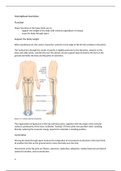Conceptual overview
Function
Major functions of the lower limbs are to:
- support the weight of the body with minimal expenditure of energy
- move the body through space
Support the body weight
When standing erect, the center of gravity is anterior to the edge of the SII (S2) vertebra in the pelvis.
The vertical line through the center of gravity is slightly posterior to the hip joints, anterior to the
knee and ankle joints, and directly over the almost circular support base formed by the feet on the
ground and holds the knee and hip joints in extension.
Figure 6.1. Center and line of gravity.
The organization of ligaments at the hip and knee joints, together with the shape of the articular
surfaces, particularly at the knee, facilitates “locking” of these joints into position when standing,
thereby reducing the muscular energy required to maintain a standing position.
Locomotion
Moving the body through space involves the integration of movements at all joints in the lower limb
to position the foot on the ground and to move the body over the foot.
Movements at the hip joint are flexion, extension, abduction, adduction, medial (internal) and lateral
(external) rotation, and circumduction.
1






